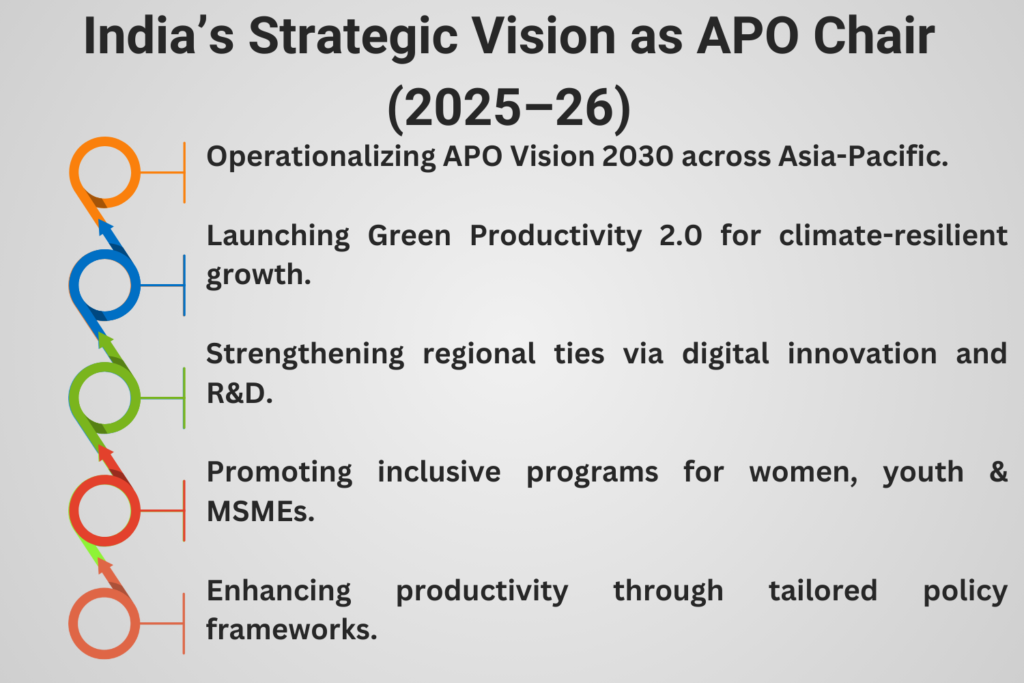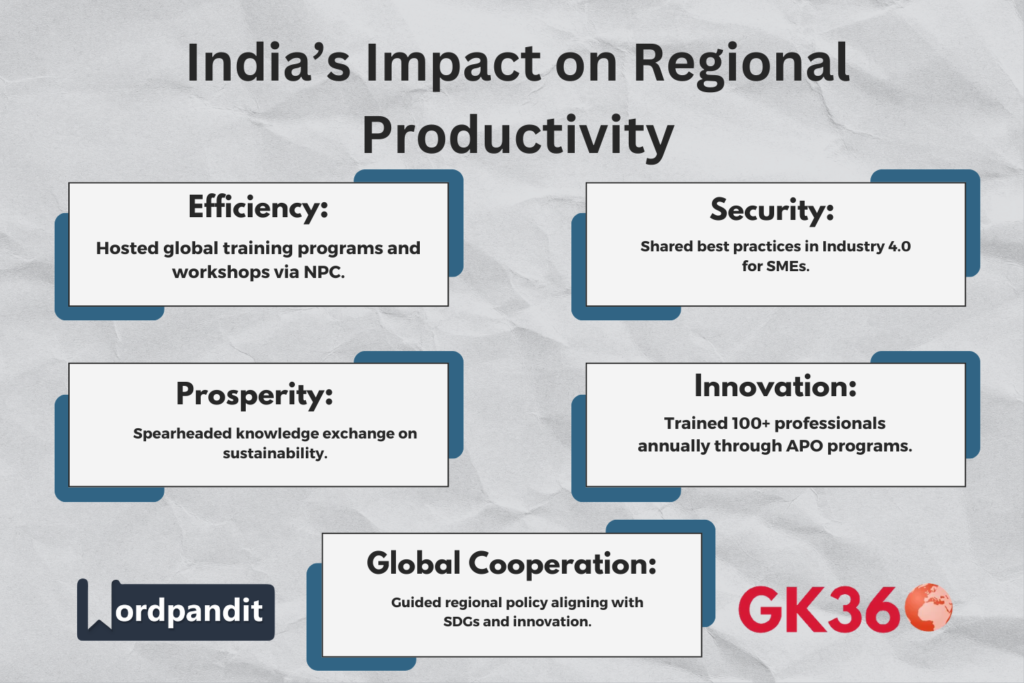India Assumes APO Chairmanship for 2025–26: Leading Asia’s Productivity Transformation
India has taken a pivotal step on the global stage by assuming the Chairmanship of the Asian Productivity Organization (APO) for the 2025–26 term. Marked during the 67th Governing Body Meeting (GBM) held in Jakarta, Indonesia (May 20–22, 2025), this transition cements India’s leadership in driving sustainable growth, digital innovation, and inclusive productivity across the Asia-Pacific.

Table of Contents
- India Takes Charge at APO: An Overview
- What is the Asian Productivity Organization (APO)?
- India’s Chairmanship Vision for 2025–26
- India’s Strategic Contributions to APO
- Challenges and Opportunities Ahead
- Frequently Asked Questions (FAQs)
- Conclusion: India’s Vision for a Productive Asia-Pacific
India Takes Charge at APO: An Overview
India’s leadership at the 67th Governing Body Meeting signifies more than a ceremonial handover. With Shri Amardeep Singh Bhatia, IAS, Secretary at the Department for Promotion of Industry and Internal Trade (DPIIT), appointed as APO Chair and India’s Director, the nation is poised to play a transformational role in shaping the organization’s productivity agenda for the Asia-Pacific.
“India’s Chairmanship reflects our belief in collaborative innovation and sustainability to drive inclusive growth,” – Shri Amardeep Singh Bhatia
What is the Asian Productivity Organization (APO)?
Established in 1961 and headquartered in Tokyo, Japan, the Asian Productivity Organization is a regional intergovernmental organization committed to boosting productivity and sustainable economic growth among its 21 member countries.
APO Member Nations Include:
- India
- Japan
- Indonesia
- Vietnam
- Iran
- South Korea
- …and others from across the Asia-Pacific.
Core Objectives:
- Enhance innovation and productivity practices
- Build capacity through training and research
- Promote sustainable, inclusive development
- Foster cross-border collaboration on technology and reforms
India, a founding member, plays a pivotal role through its implementing body—the National Productivity Council (NPC).
India’s Chairmanship Vision for 2025–26
1. Advancing APO Vision 2030
India aims to operationalize APO Vision 2030, a long-term roadmap that seeks to transform Asia into a productivity-centric economic zone. This includes setting benchmarks, accelerating innovation, and creating measurable outcomes for member states.
2. Green Productivity 2.0: A Sustainable Shift
A key pillar of India’s strategy is Green Productivity 2.0, which blends economic efficiency with environmental stewardship.
Key Goals:
- Scale green technologies in agriculture and manufacturing
- Develop sustainability frameworks for SMEs
- Lead regional knowledge exchange on climate-resilient productivity models
3. Promoting Regional Cooperation
India is championing collaborative programs across critical areas like:
- Digital Transformation – Upskilling sectors with AI, automation, and analytics
- Innovation – Promoting R&D, smart technologies, and scalable solutions
- Sustainability – Mainstreaming circular economy models
- Entrepreneurship – Nurturing startups and MSMEs for inclusive development
4. Inclusive, Results-Oriented Programs
India advocates for tailored capacity-building initiatives that align with:
- Local productivity needs
- Measurable outcomes
- Inclusive participation from women, youth, and disadvantaged groups
India’s Strategic Contributions to APO
India has long contributed to APO through robust initiatives led by NPC, such as:
- Hosting training programs and international workshops
- Sharing best practices in Industry 4.0 for MSMEs
- Promoting green productivity case studies
- Facilitating exchange programs with over 100 Indian professionals trained annually
India’s Impact on Regional Productivity Goals
India’s APO Chairmanship arrives at a pivotal time when the Asia-Pacific region is navigating economic recovery, digital acceleration, and climate resilience. India is strategically positioned to guide member nations by:
- Setting policy frameworks aligned with sustainable development goals (SDGs)
- Encouraging digital capacity-building for micro and small enterprises
- Supporting technology transfer and innovation ecosystems
India’s leadership serves as a catalyst for regional productivity by ensuring that growth is inclusive, equitable, and environmentally sound.
Challenges and Opportunities Ahead
Key Challenges
- Diverse Development Levels: Bridging the productivity gap between developed and developing APO members
- Resource Constraints: Ensuring equitable access to training and tools for smaller economies
- Technology Gaps: Accelerating digital infrastructure in under-resourced regions
- Policy Harmonization: Aligning national goals with APO-wide strategies
Opportunities
- Drive Smart Manufacturing initiatives
- Lead green innovation partnerships
- Shape regional digital governance frameworks
- Position India as a hub for productivity thought leadership

Frequently Asked Questions (FAQs)
1. What is APO Vision 2030 and why is it important?
APO Vision 2030 is a strategic roadmap aimed at transforming Asia-Pacific into a productivity-driven region through innovation, sustainability, and inclusive growth.
2. Who is leading India’s APO efforts?
Shri Amardeep Singh Bhatia, IAS, Secretary of DPIIT, serves as India’s APO Director and Chair for 2025–26.
3. What is Green Productivity 2.0?
It is a next-generation sustainability model that integrates eco-efficiency into all aspects of production and development, with India leading its regional implementation.
4. How is India supporting other APO member nations?
Through capacity-building programs, digital transformation support, training workshops, and policy exchange initiatives led by NPC.
5. How can businesses and professionals in India benefit from APO programs?
They gain access to international best practices, training, collaboration opportunities, and participation in high-impact projects designed to boost productivity.
Conclusion: India’s Vision for a Productive Asia-Pacific
India’s assumption of the Chairmanship of the Asian Productivity Organization (APO) for 2025–26 marks a defining moment in its regional leadership journey. Guided by APO Vision 2030, Green Productivity 2.0, and an unwavering focus on digital transformation and inclusion, India is not just participating in global productivity efforts—it is leading them.
Under the stewardship of Shri Amardeep Singh Bhatia and backed by the National Productivity Council, India is poised to create measurable, lasting impact across Asia-Pacific.





